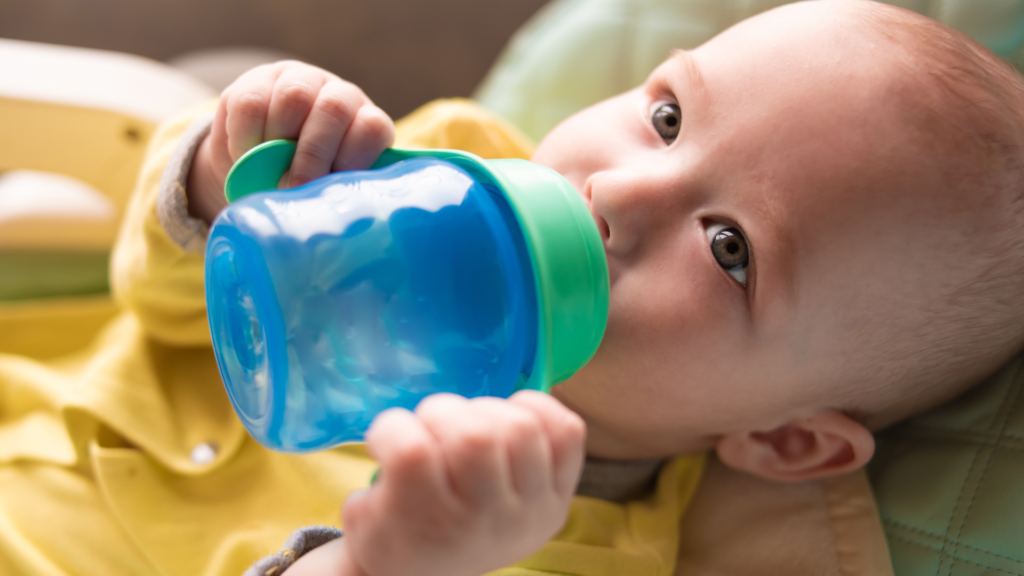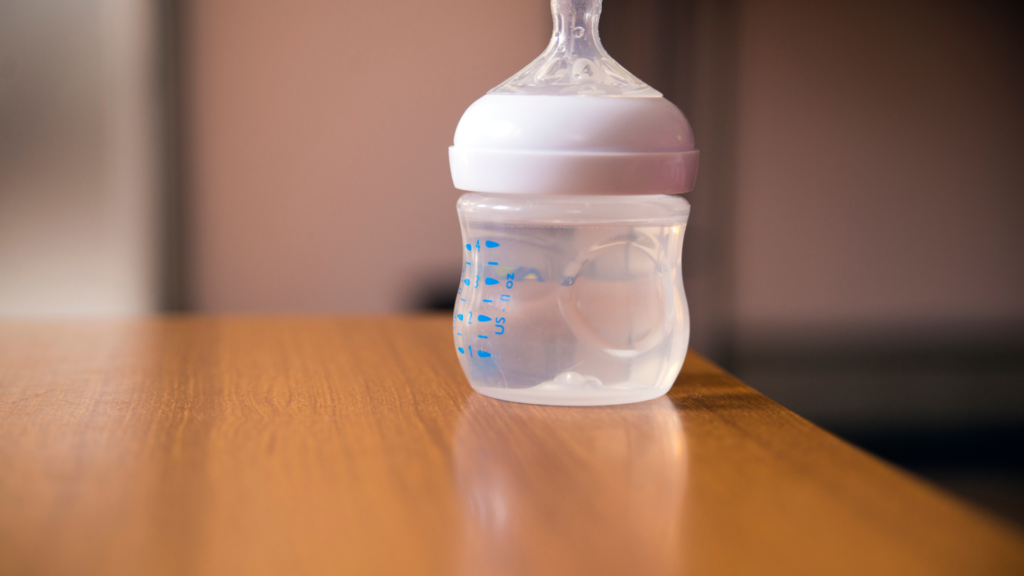Proper hydration is essential for babies at various stages of their growth and development. Keeping up with their changing hydration needs can be a challenge, and it’s essential to strike the right balance between adequate hydration and the overall nutrition they receive from breast milk, formula, and solid foods.
In this guide, we will explore various aspects of baby hydration, including age-specific requirements, factors influencing hydration needs, signs of dehydration, the role of breast milk and formula, and introducing water and other fluids to your baby’s diet. Let’s embark on this journey together!

Understanding Infant Hydration Needs
Proper hydration is vital for newborns and growing babies. It helps in maintaining body functions and developing physical and cognitive growth. Let’s delve into the specifics of infant hydration needs.
Age-Specific Hydration Requirements
Each stage of a baby’s growth comes with specific hydration needs. These hydration needs can vary based on the baby’s weight, diet, activity level, and weather conditions.
- Newborns: Babies under 6 months who are exclusively breastfed or formula-fed generally do not require additional water.
- 6 to 12 months: Babies can start having small amounts of water once they begin eating solid foods, around 4-6 fluid ounces (120-180 ml) in a day.
- 12 months and above: As babies grow into toddlers, their water intake should increase proportionally with their diet, around 1 to 4 cups a day.
Factors Influencing Hydration Needs
Several factors influence the hydration needs of a baby:
- Diet: Babies on a solid diet may require more water than those exclusively on breast milk or formula.
- Climate: Hot weather can lead to increased water loss and, thus, increased hydration needs.
- Illness: During times of sickness, especially those involving fever, vomiting or diarrhea, babies may require more fluids.
Signs of Dehydration in Babies
Just like adults, babies can also undergo severe dehydration when the fluid loss is more than their intake. Here are a few signs that you can keep an eye out for:
- Infrequent wet diapers (less than six in 24 hours)
- Dark yellow urine
- Unusual sleepiness or lethargy
- Dry mouth and lips
- No tears while crying
Proper hydration is fundamental for a baby’s comprehensive wellness. It’s always advisable to ground consultations with your healthcare provider to cater to your baby’s specific hydration needs, especially for young children ages under five. If you observe any signs of dehydration, ensure to seek immediate medical help. The use of an oral rehydration solution can aid in replenishing lost fluids and electrolytes.
Breast Milk and Formula as Primary Sources of Hydration
Breast milk and formula are essential sources of hydration for newborns and infants, providing them with the necessary fluids along with vital nutrients for development and growth. Let’s delve into their respective roles and impacts on hydration.
Role of Breast Milk in Hydration
Breast milk is often considered the ideal source of hydration and nutrition for newborns and infants for a variety of reasons:
- Perfect Composition: As the mother’s body alters the composition of the milk, it includes the right balance of water, nutrients, and fats, meeting the baby’s specific hydration and nutritional needs.
- Natural Properties: Besides providing hydration, breast milk also contains antibodies to boost the baby’s immune system and protect against infections.
- Dynamic Changes: Breast milk composition and fluid content change within a feeding session, starting with watery, thirst-quenching foremilk, which shifts to creamier, fat-rich hindmilk to satisfy hunger.

Formula Feeding and Its Impact on Hydration
Formula, an alternative to breast milk, also plays a significant role in infant hydration:
- Hydration and Nutrition: While not as dynamic as breast milk, formula provides the necessary fluids along with essential nutrients like proteins, carbohydrates, and fats required for growth and development.
- Water Content: Given that infant formula is prepared by blending with water, it acts as a reliable source of hydration for the baby. This aspect is especially crucial when you bottle feed your baby, as formula acts as both a meal and a hydrating agent.
- Suitability: Formula works as a wholesome alternative for those who cannot or choose not to breastfeed.
Establishing a Feeding Routine
Establishing a proper feeding routine contributes to the infant’s hydration and overall well-being. Some basic tips include:
- Feeding on Demand: Feeding newborns and infants when they show signs of hunger is of utmost importance. This ensures they receive adequate hydration and nourishment, helping prevent dehydration.
- Amount and Frequency: Newborns typically require 8 to 12 feedings in a day. Discuss with your pediatrician to find what’s best for your baby, as every infant’s needs may vary.
- Observing Growth and Diaper Output: Keep track of your baby’s growth and the number of wet diapers to ensure they are receiving sufficient hydration and nutrition.
- Transition to Solids: Introducing solids at around 6 months is essential for the baby’s development but remember to continue breastfeeding or providing formula for appropriate hydration and nutrition.
Both breast milk and formula play a pivotal role in the hydration landscape of newborns and infants. They do not just supply the necessary fluids, but also significantly contribute to promoting healthy cognitive and physiological growth. Hence, as a parent, it’s essential to efficiently bottle feed and keep your baby well-hydrated and nourished.
Introduction to Water for Babies
Offering water to babies stands as a crucial milestone in their growth and development training. Familiarizing oneself with the right time to start, incorporating suitable intake quantities, and understanding necessary precautions can ensure ideal hydration without undermining their nutrition systematically.
Standardized timelines for presenting water to babies include:
- Under 6 months: Infants who are solely reliant on breastfeeding or formula-feeding generally do not necessitate additional water for hydration, as their milk sources provide ample fluids and nourishment.
- 6 to 12 months: When babies start to consume solid foods, it’s appropriate to slowly incorporate small quantities of water to supplement their hydration needs.
Water consumption should be modulated for varying age groups to ensure apt hydration:
- 6 to 12 months: Incorporate around 4-6 fluid ounces (120-180 ml) of water every day. This can be served in small sips scattered across the day.
- 1 to 3 years: With the evolution of babies into toddlers, their water intake should upscale, ideally ranging between approximately 1 to 4 cups (240-960 ml) each day. This can vary based on their activity levels, diet, and climate.
It is advisable to consult your pediatrician or baby’s doctor to tailor-match the hydration needs of your baby based on their specific traits and developmental parameters.

While administering water to babies, several critical precautions need to be entertained:
- Water Type: Utilize safe and clean drinking water, like tap water or boiled and then cooled water, in line with the recommendations and water quality prevalent in your area.
- Temperature: Avoid presenting icy-cold or hot water. It should be dispensed at a comfortable, lukewarm temperature.
- Avoiding Displacement: Excessive water should not be given to babies, as it might sideline the essential nutrients procured from breast milk or formula, especially during bottle feeding.
- Age-appropriate Vessels: Always rely on age-suited sippy cups, open cups, or bottles for babies.
- Gradual Introduction: Offer water gradually, and abstain from forcing your baby if they seem reluctant. This methodology helps them to develop their taste buds and accept it as part of their diet slowly but steadily.
Incorporating water into babies’ diet forms a critical component in providing balanced hydration supplemented by nutrition from breast milk, formula, or solid foods. It’s crucial to keep your child hydrated, especially when they have a sore throat or show signs of mild dehydration. In these scenarios, one might even resort to sports drinks, only if suggested by the child’s doctor. Always keep an eye on the hydration status of older babies and escalate it to their doctor if any hydration shortcomings are visible.
Preparing and Offering Water Safely
When it comes to providing safe and refreshing water, there are several essential factors to consider. Ensuring that the water we drink is free from contaminants and impurities is crucial for maintaining good health. Here are a few guidelines to keep in mind while preparing and offering water:
- Proper water storage: Store water in a clean, cool, and dry place, away from direct sunlight. Keep it well sealed to prevent the growth of bacteria, algae, or other microorganisms.
- Suitable containers for serving water: Choose the right container for serving water, such as a glass, stainless steel, or BPA-free plastic bottle. Avoid using containers made of materials that could leach harmful chemicals into the water.
- Temperature considerations: Serve water at the appropriate temperature, typically cold or room temperature, depending on personal preference. Be aware of how long water has been sitting at a specific temperature – stagnant water can develop a stale taste and become a breeding ground for bacteria.
- Avoiding contaminants and impurities: Regularly clean the water containers and dispenser systems to keep them free from molds, algae, or any other contaminants. When offering water, make sure not to let your hands or other objects come in contact with the water, as this can introduce contaminants. Always use clean cups, glasses, or bottles for serving.
Transitioning to Solid Foods and Other Liquids
Transitioning a baby from a milk-only diet to consuming varied foods and liquids can be an exciting developmental period. However, it should be managed gently to ensure the baby’s health, comfort, and acceptance of new tastes.
Introduction of Complementary Foods
Complementary foods are introduced to a baby’s diet generally after the first six months of life when breast milk or infant formula alone is no longer adequate to meet the growing nutritional demands of the infant.
- Start slow: Begin by introducing foods one at a time with a minimal quantity. Single-ingredient foods are best.
- Safe textures: Start with spoonable foods, like purees, before progressing to mashed and chopped food as your baby begins to handle new textures.
- Diverse foods: Gradually add variety, from fruits and vegetables to grains, dairy products, and meats.

Types of Liquids To Offer
When your baby is ready to consume more than just breast milk or formula, several options are available:
- Diluted fruit juices: They can provide some vitamins and minerals but should be offered in moderation. Never more than 4 ounces a day.
- Water: Once your baby starts eating solid foods, you can start offering a few ounces of water each day.
- Cows milk: Babies should not be given cows milk until they are one year old.
Monitoring Baby’s Response to New Fluids
As you introduce new fluids, keep a close watch on your baby’s reactions and digestion to ensure they are tolerating new liquids well.
- Allergic Reactions: Look out for rashes, vomiting, or diarrhea. These cues might signal that your baby’s system is having trouble processing certain substances.
- Hydration status: Monitor the number of wet diapers per day to ensure your baby is well hydrated.
- Growth patterns: Adequate weight gain and development over time are crucial markers of nutritional sufficiency. Regular pediatrician visits can help in this monitoring process.
Tips for Ensuring Adequate Hydration
Understanding the difference between hunger and thirst can be instrumental in ensuring proper hydration. Dehydration may often disguise itself as hunger. Before reaching for a snack, try to drink a glass of water first and see if the feeling subsides.
- Satiety: You feel a sense of fullness and typically stop eating.
- Thirst: This can be a feeling of dryness in the throat or mouth, decreased urine output, or a heady feeling of lightheadedness.
Hydration during Hot Weather
During hot weather, it’s essential to increase your water intake to replace the fluids lost due to sweating.
- Drink before you feel thirsty: Thirst is not always an ideal indicator of hydration status.
- Plain water is best: Avoid beverages high in sugar and caffeine, which could lead to increased urine production and possible dehydration.
- Consume hydrating foods: Fruits and vegetables with a high water content can contribute to your fluid intake.
Traveling with a Hydrated Baby
Keeping a baby hydrated while traveling is important, as they can become dehydrated much quicker than adults.
- Breastfeed regularly: If your baby is breastfeeding, feeding frequently can help keep them hydrated.
- Bring extra fluids: For babies consuming solids, bring extra fluids like water or pediatric electrolyte solutions.
- Watch for signs of dehydration: These may include fewer wet diapers, a dry mouth, or sunken eyes.
Maintaining a Well-Balanced Diet
A balanced diet can contribute to overall hydration, as many foods contain significant quantities of water.
- Include high-moisture foods: Include fruits, vegetables, and soups in your diet to add to your daily fluid intake.
- Stay clear of high-salt foods: These can cause your body to lose more water.
- Healthy beverages: Add beverages like herbal tea and fruit-infused water to your diet to not only remain hydrated but also to receive added nutritional benefits.
- Hydrate before meals: Consuming water before meals can aid in overall digestion and nutrient absorption.
Remember that good hydration is integral to overall health and well-being. Always pay attention to your body’s signals and adjust your intake as necessary.

Conclusion
In conclusion, hydrating your baby adequately is as critical as providing the necessary nutrition. Each stage in your baby’s life requires different amounts and types of fluids, ranging from breast milk and formula in the early months to the cautious addition of water and other fluids as they reach the solid food phase. Understanding age-specific hydration requirements, recognizing signs of dehydration, and being mindful of the influences of diet, climate, and illness are crucial.
Finally, as you pour love into the journey of raising your little one, keep the pitchers of patience and persistence handy. Stay informed, seek advice when in doubt, and remember that this tricky yet precious phase of infancy passes faster than you might think. So, cheers to these little steps leading to considerable milestones! And remember, every drop counts when hydrating your baby.
Did this article help you? Please let us know in the comments. If you have any questions, don’t hesitate to ask.



